Unit6--Clothes--教案(第二课时)
- 格式:doc
- 大小:40.00 KB
- 文档页数:6
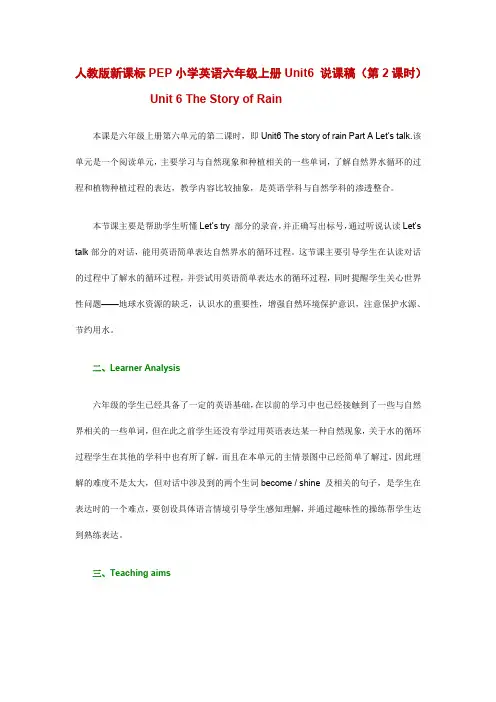
人教版新课标PEP小学英语六年级上册Unit6 说课稿(第2课时)Unit 6 The Story of Rain本课是六年级上册第六单元的第二课时,即Unit6 The story of rain Part A Let’s talk.该单元是一个阅读单元,主要学习与自然现象和种植相关的一些单词,了解自然界水循环的过程和植物种植过程的表达,教学内容比较抽象,是英语学科与自然学科的渗透整合。
本节课主要是帮助学生听懂Let’s try 部分的录音,并正确写出标号,通过听说认读Let’s talk部分的对话,能用英语简单表达自然界水的循环过程。
这节课主要引导学生在认读对话的过程中了解水的循环过程,并尝试用英语简单表达水的循环过程,同时提醒学生关心世界性问题——地球水资源的缺乏,认识水的重要性,增强自然环境保护意识,注意保护水源、节约用水。
二、Learner Analysis六年级的学生已经具备了一定的英语基础,在以前的学习中也已经接触到了一些与自然界相关的一些单词,但在此之前学生还没有学过用英语表达某一种自然现象,关于水的循环过程学生在其他的学科中也有所了解,而且在本单元的主情景图中已经简单了解过,因此理解的难度不是太大,但对话中涉及到的两个生词become / shine 及相关的句子,是学生在表达时的一个难点,要创设具体语言情境引导学生感知理解,并通过趣味性的操练帮学生达到熟练表达。
三、Teaching aims根据教材的编排意图和学生的实际情况,结合新课标对高年级学生的具体要求,制定如下教学目标:1.能听懂Let’s try 部分的录音内容,完成标号练习。
2. 能听说认读本课对话,了解水的循环过程。
3. 能听说读写粗体句子,并熟练掌握主要句型:Where does the … come from? It comes from the ….4.能用英语简单描述自然界水的循环过程。
在外语教学中,学生只有在真实的语言情景或模拟情景中才能更好地理解所传递的信息和语言材料,才能激活学生的思维,从内心产生表达思想、展示自我的欲望。
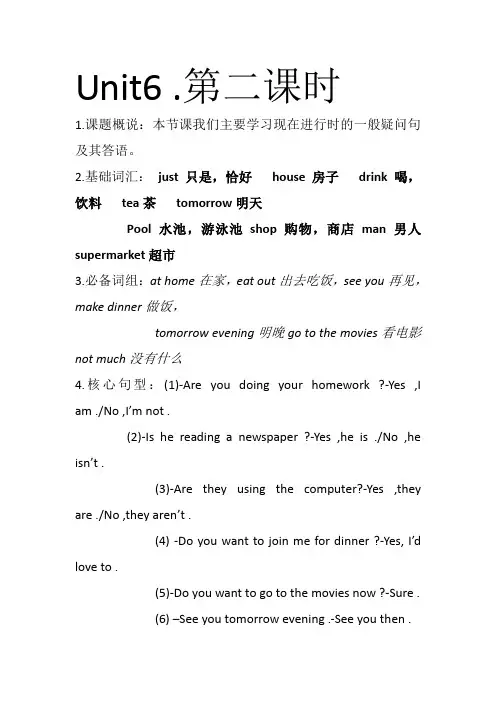
Unit6 .第二课时1.课题概说:本节课我们主要学习现在进行时的一般疑问句及其答语。
2.基础词汇:just只是,恰好house房子drink 喝,饮料tea茶tomorrow明天Pool水池,游泳池shop购物,商店man男人supermarket超市3.必备词组:at home在家,eat out出去吃饭,see you再见,make dinner做饭,tomorrow evening明晚go to the movies看电影not much没有什么4.核心句型:(1)-Are you doing your homework ?-Yes ,I am ./No ,I’m not .(2)-Is he reading a newspaper ?-Yes ,he is ./No ,he isn’t .(3)-Are they using the computer?-Yes ,they are ./No ,they aren’t .(4) -Do you want to join me for dinner ?-Yes, I’d love to .(5)-Do you want to go to the movies now ?-Sure .(6) –See you tomorrow evening .-See you then .5.课文鸟瞰:读下面的对话,回答问题。
Jenny: Hello? This is Jenny .Laura: Hi , Jenny .It’s Laura here .Jenny: Oh ,hi, Laura .What are you doing ?Laura: Not much .I’m just washing my clothes .What about you ?Jenny: I’m watching TV .Do you want to join me for dinner ?My parents aren’t at home .We can eat outLaura: Yeah ,I’d love to .Jenny: Let’s meet at my home first .Come at half past six .Laura: OK .See you then .Q1.What’s Jenny doing ?Q2.Does Laura like to have dinner with Jenny ?Q3.When will they meet ?6.【巩固练习】将下列句子排列顺序,组成对话。
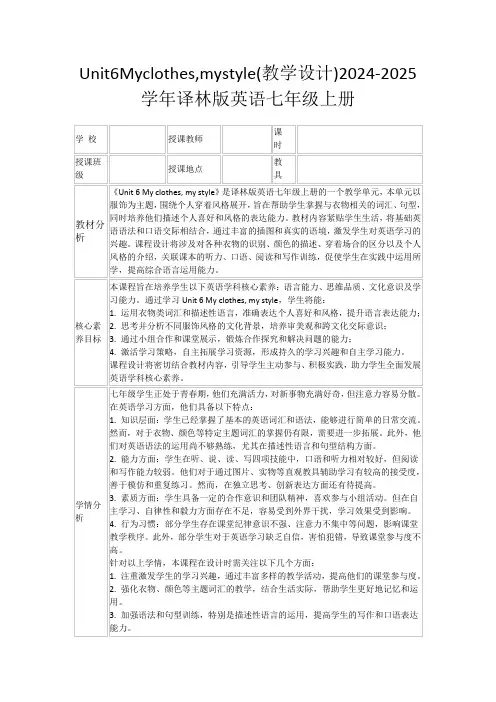
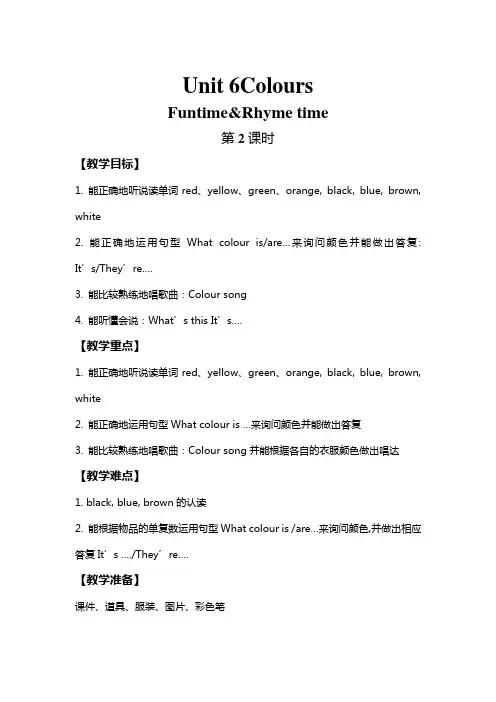
Unit 6ColoursFuntime&Rhyme time第2课时【教学目标】1. 能正确地听说读单词red、yellow、green、orange, black, blue, brown, white2. 能正确地运用句型What colour is/are…来询问颜色并能做出答复: It’s/They’re….3. 能比较熟练地唱歌曲:Colour song4. 能听懂会说:What’s this It’s….【教学重点】1. 能正确地听说读单词red、yellow、green、orange, black, blue, brown, white2. 能正确地运用句型What colour is …来询问颜色并能做出答复3. 能比较熟练地唱歌曲:Colour song并能根据各自的衣服颜色做出唱达【教学难点】1. black, blue, brown的认读2. 能根据物品的单复数运用句型What colour is /are…来询问颜色,并做出相应答复It’s …./They’re….【教学准备】课件、道具、服装、图片、彩色笔【教学过程】Step 1 Warm-up1. Greetings2. Free talkA: Good morning/Hello….B:Good morning/Hello. Miss Li. How are youA:I’m fine, thank you. Look, this is my friend/father. What colour is his/her…A: Look at my …. What colour is itStep 2 Review1.T: Yang Ling likes fashion show. What does she showT: How does she say Let’s look and say2.T: What colour are her skirtsT: OK. Show me the colour: red. green, yellow, orange.T: There is a box on the desk. What colour is the boxT: What’s in the box Open it and have a look.T: What colour is itblue, brown,black,whiteStep 3Practice1). Ask and answerWhat colour is this…2). Read and match3). Game:What colour is missingWhatcolours are missingStep 4Song timeT: Now, let’s listen to a song. What song is it Let’s listen.1.T: What colour can you hearDo you remember the songWho’s wearing yellow today2. Learn to sing a song3. Sing a songSing together, in groups, At last:Ss: Who is wearing yellow today, yellow today Who is wearing yellow today.Step 5Fun time1.Play and sayT: Colourful clothes, colourful life. There are some clothes. What are theseT: And what colour are they Let’s play and say.Model: T〔转转盘〕:What colour is this T-shirtT: Do you want to play Let’s think and say the sentences at first. Play and say( 8 students)2. Look and sayRulers: 2人一组,准备2套卡片,一套是服饰,一套是颜色。

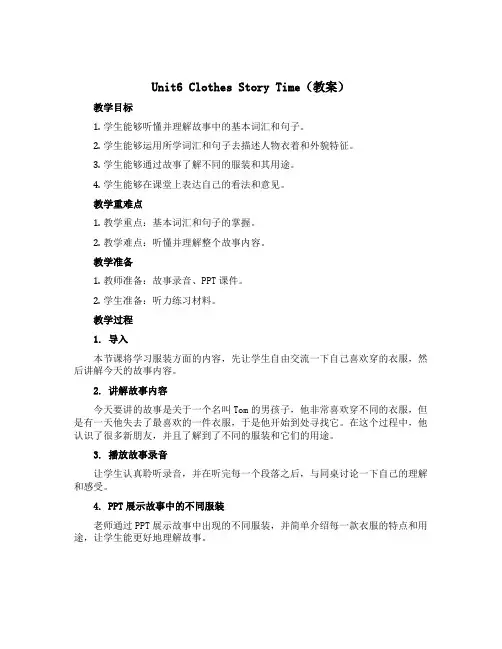
Unit6 Clothes Story Time(教案)教学目标1.学生能够听懂并理解故事中的基本词汇和句子。
2.学生能够运用所学词汇和句子去描述人物衣着和外貌特征。
3.学生能够通过故事了解不同的服装和其用途。
4.学生能够在课堂上表达自己的看法和意见。
教学重难点1.教学重点:基本词汇和句子的掌握。
2.教学难点:听懂并理解整个故事内容。
教学准备1.教师准备:故事录音、PPT课件。
2.学生准备:听力练习材料。
教学过程1. 导入本节课将学习服装方面的内容,先让学生自由交流一下自己喜欢穿的衣服,然后讲解今天的故事内容。
2. 讲解故事内容今天要讲的故事是关于一个名叫Tom的男孩子,他非常喜欢穿不同的衣服,但是有一天他失去了最喜欢的一件衣服,于是他开始到处寻找它。
在这个过程中,他认识了很多新朋友,并且了解到了不同的服装和它们的用途。
3. 播放故事录音让学生认真聆听录音,并在听完每一个段落之后,与同桌讨论一下自己的理解和感受。
4. PPT展示故事中的不同服装老师通过PPT展示故事中出现的不同服装,并简单介绍每一款衣服的特点和用途,让学生能更好地理解故事。
5. 让学生就故事中的问题进行讨论老师提出故事中出现的问题并让学生自由讨论,比如Tom为什么失去了他最喜欢的衣服? Tom在寻找衣服的过程中是否遇到一些新朋友? 学生可以用英文讨论这些问题。
6. 让学生之间互相交流衣着和外貌特征老师安排学生之间互相合作进行英文交流,让他们用所学的词汇和句子来描述彼此的衣着和外貌特征。
7. 让学生总结今天的学习内容老师让学生回答几个问题,总结今天学习的内容,以及他们从故事中学到了什么。
教学反思本节课通过讲故事的方式来教授服装方面的知识,让学生在听故事的过程中,能够更好地学习并掌握词汇和句子。
此外,通过学生之间的交流,能够更好地提高其口语表达能力。
但是,故事需要通过PPT的形式来辅助,如果PPT不能正常使用,可能会影响教学效果。
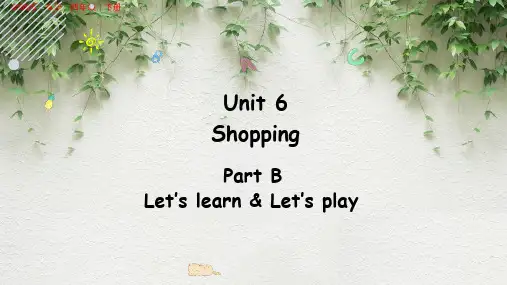
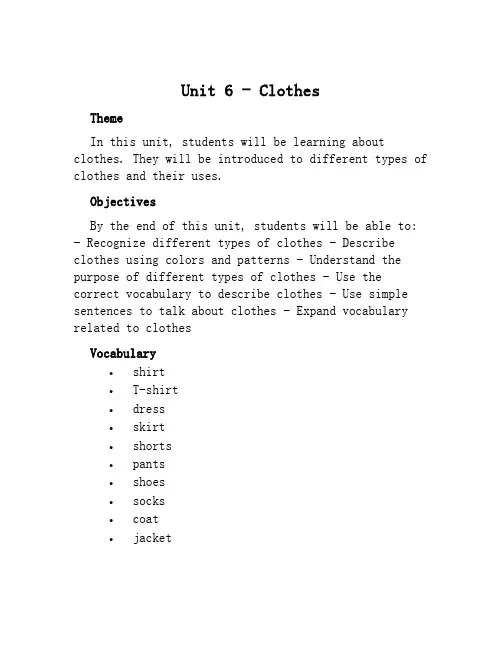
Unit 6 - ClothesThemeIn this unit, students will be learning about clothes. They will be introduced to different types of clothes and their uses.ObjectivesBy the end of this unit, students will be able to: - Recognize different types of clothes - Describe clothes using colors and patterns - Understand the purpose of different types of clothes - Use the correct vocabulary to describe clothes - Use simple sentences to talk about clothes - Expand vocabulary related to clothesVocabulary•shirt•T-shirt•dress•skirt•shorts•pants•shoes•socks•coat•jacketWarm-UpTo get students engaged in the topic of clothes, you can start off with a simple activity. Have students briefly describe what they are wearing and what they like about their clothing.Example prompts could include: - What color is your shirt? - Do you like your shoes? - What type of pants are you wearing?This activity will help students start thinking about clothes and the different parts that make up an outfit.PresentationAfter the warm-up, introduce the vocabulary related to clothes to the students. Use pictures or real items to show the different types of clothes and their names.Make sure to also mention the different uses for each type of clothing. For example, a coat is used to keep warm in cold weather and shoes protect our feet when walking.PracticeTo reinforce the vocabulary, have the students do some practice exercises. This can include writing out the vocabulary words, matching pictures to words, or even a simple game of charades where students act out the different types of clothing.You can also have students practice using simple sentences to describe clothes. For example,。
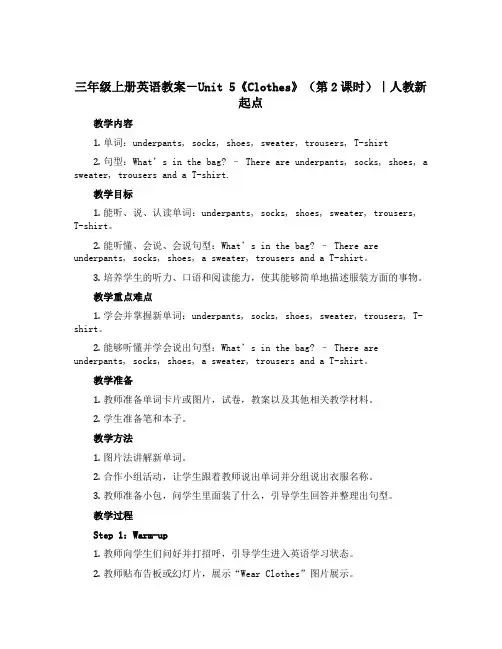
三年级上册英语教案-Unit 5《Clothes》(第2课时)|人教新起点教学内容1.单词:underpants, socks, shoes, sweater, trousers, T-shirt2.句型:What’s in the bag? – There are underpants, socks, shoes, a sweater, trousers and a T-shirt.教学目标1.能听、说、认读单词:underpants, socks, shoes, sweater, trousers, T-shirt。
2.能听懂、会说、会说句型:What’s in the bag? – There are underpants, socks, shoes, a sweater, trousers and a T-shirt。
3.培养学生的听力、口语和阅读能力,使其能够简单地描述服装方面的事物。
教学重点难点1.学会并掌握新单词:underpants, socks, shoes, sweater, trousers, T-shirt。
2.能够听懂并学会说出句型:What’s in the bag? – There are underpants, socks, shoes, a sweater, trousers and a T-shirt。
教学准备1.教师准备单词卡片或图片,试卷,教案以及其他相关教学材料。
2.学生准备笔和本子。
教学方法1.图片法讲解新单词。
2.合作小组活动,让学生跟着教师说出单词并分组说出衣服名称。
3.教师准备小包,问学生里面装了什么,引导学生回答并整理出句型。
教学过程Step 1:Warm-up1.教师向学生们问好并打招呼,引导学生进入英语学习状态。
2.教师贴布告板或幻灯片,展示“Wear Clothes”图片展示。
Step 2:New Words1.向学生展示单词卡片或图片。
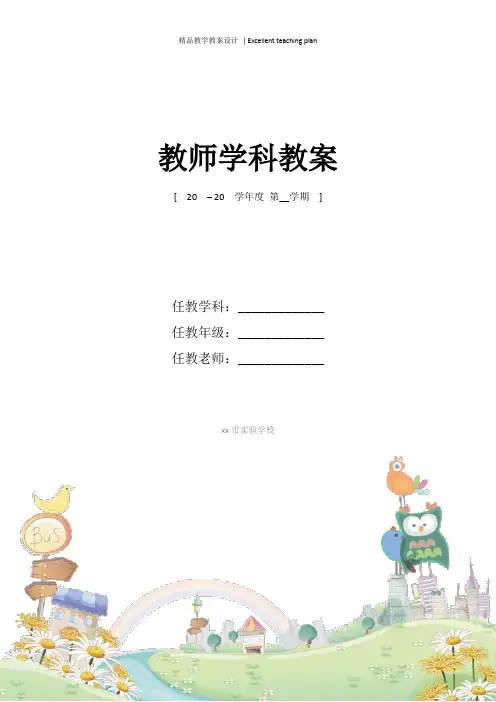
教师学科教案[ 20 – 20 学年度第__学期]任教学科:_____________任教年级:_____________任教老师:_____________xx市实验学校Unit6 Clothes (1)Part B教案一、教学目标1、学习单词want和sports shoes,并懂得运用。
2、学习句子:They’re too small / big.I want my sports shoes, too.3、学习字母t和d在单词中的读音。
4、学说韵律诗:My T-shirt and Sports Shoes.二、教学重点1、学习新词:sports shoes2、学习句子:They’re too small / big.I want my sports shoes, too.三、教学难点熟练运用句型:They’re too small / big. I want my sports shoes, too.四、教学过程Step 1: Warm-up1、Greetings2、全班齐唱歌曲:Who Is Wearing a T-shirt Today?3、揭示并板书课题:Unit 6 Clothes (1) Part BStep 2:Presentation(一) 教授单词sports shoes和句子I want….1、教师播放录音,请全班学说韵律诗:My T-shirt and Sports Shoes.初步感知sports shoes 的含义。
2、教师指着自己脚上的运动鞋说:“They’re sports shoes.”接着采用不同方法教学单词和句子,并板书。
3、教学单词want和句子I want….(二)课文教学1、今天正在举行森林运动会。
运动场上,猴子队长一边给动物们发运动会入场式穿的运动鞋,熊正在穿鞋,但鞋太小,它穿得很费劲。
于是,它生气地说:“They’re too small.”(太小了。
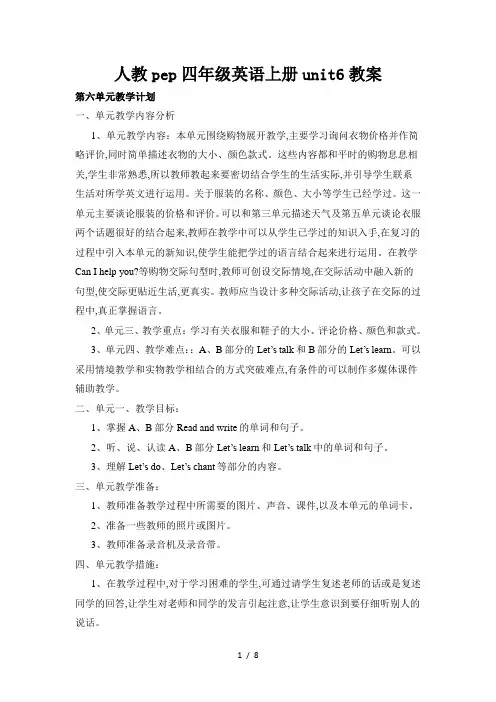
人教pep四年级英语上册unit6教案第六单元教学计划一、单元教学内容分析1、单元教学内容:本单元围绕购物展开教学,主要学习询问衣物价格并作简略评价,同时简单描述衣物的大小、颜色款式。
这些内容都和平时的购物息息相关,学生非常熟悉,所以教师教起来要密切结合学生的生活实际,并引导学生联系生活对所学英文进行运用。
关于服装的名称、颜色、大小等学生已经学过。
这一单元主要谈论服装的价格和评价。
可以和第三单元描述天气及第五单元谈论衣服两个话题很好的结合起来,教师在教学中可以从学生已学过的知识入手,在复习的过程中引入本单元的新知识,使学生能把学过的语言结合起来进行运用。
在教学Can I help you?等购物交际句型时,教师可创设交际情境,在交际活动中融入新的句型,使交际更贴近生活,更真实。
教师应当设计多种交际活动,让孩子在交际的过程中,真正掌握语言。
2、单元三、教学重点:学习有关衣服和鞋子的大小、评论价格、颜色和款式。
3、单元四、教学难点::A、B部分的Let’s talk和B部分的Let’s learn。
可以采用情境教学和实物教学相结合的方式突破难点,有条件的可以制作多媒体课件辅助教学。
二、单元一、教学目标:1、掌握A、B部分Read and write的单词和句子。
2、听、说、认读A、B部分Let’s learn和Let’s talk中的单词和句子。
3、理解Let’s do、Let’s chant等部分的内容。
三、单元教学准备:1、教师准备教学过程中所需要的图片、声音、课件,以及本单元的单词卡。
2、准备一些教师的照片或图片。
3、教师准备录音机及录音带。
四、单元教学措施:1、在教学过程中,对于学习困难的学生,可通过请学生复述老师的话或是复述同学的回答,让学生对老师和同学的发言引起注意,让学生意识到要仔细听别人的说话。
2、对于学习还不错,但是不愿或害怕发言的学生,课堂中教师主动请他们表达其意见,培养他们良好的学习英语的习惯。
教研主题:听常规,研教法教研方式:听评课教材:剑桥英语1册年级:四年级教师:李静Unit 6 Clothes (5)一、Teaching content1. The pupils understand、read and remember the poem2. Playing the guessing game in the class.3. Using the sentences : What am I wearing?I think, a (green shirt) and (blue jeans). Put on your…二、Teaching aim1. 知识与能力:The pupils can read and remember the poem; play the games in the class.2.过程与方法:listen, read, speak and remember; play games.3.情感态度价值观:Pupils can use sentences to describe the clothes that they wear. They are interested in learning English.三、The key points: Pupils can use the sentence: Put on your…四、Difficult teaching points: Pupils can use the sentences: What am I wearing?I think, a (green shirt) and (blue jeans).五、Teaching aids: Teaching pictures of clothes, ppt. radio, cassette.六、Teaching processStep1.Review the words and phrases1.Present the title- Unit6 Clothes2. Read the words: T-shirt/dress/ jeans/sweater/ shirt/ socks/ shorts/ shoes/ trainers/ skirt/ capPupils read the words in lines; spell some words3. Say the phrases as: a yellow shirt/ brown jeansShowing the pictures in ppt.; pupils say out the phrasesStep2. Learn the poem.1.Read the title:Explain: poem; Can you remember the text?Pupils can understand the text.2.Listen to the poem for the first time.3.Listen to the poem for the second time and learn—Run out of the doorActions: Stand up/ Sit down/ jump/ Fly like a budgie/ Get out of the bed/Run like a rabbit/ Run slowly/ Run quicklyxx, run out of the door. (Pupils understand the text.)Using the similar phrases and word to learn the sentence- Run out of the door4 groups read one group by one group; read in lines; boys and girls read4. Listen and read one sentence by one sentenceSome pupils read; boys read, girls read; read together5.T remember the poem; A pupil remember; Practice in pairs; Some pupilsremember; remember together6.Expansion:Put on my….Step3. Play the game1.Look at some pupils to describe the clothes of the childrenWhat’s she/ he wearing? She/ He is wearing…2.T:What am I wearing?/What’s Miss Li wearing? Ss:3.Look at part 10: Learn to say—What am I wearing? & I thinkExplain the word- “I think”4.Play the game-some pairs5.Practice in pairs and actStpe4. Home taskDraw parents’ clothes, use the sentences to describe their parents’ clothes七、Blackboard designUnit 6 ClothesGet out of the bed.Run.Run out of the door.Put on your/my…What am I wearing?I think…教学反思—注重知识的理解运用,注重学生的整体参与本节课是英语组“听常规,研究法”的启动课,因此我认真的研读教材并备课,精心地准备了课件。
Unit6--Clothes--教案(第二课时)Unit6 Clothes (part3﹠part4) 教案Teaching content:Join in Book1 Unit6 Part 3 Mime the action story and part4 Listen fill in the numbers.Teaching aims:1、Revision the words: clothes ,T-shirt , shorts, socks, trainers ,2、Learning new words: alarm clock 、cycle helmet.3、To understand the sentence patterns: turn off…、get out of… put on…Teaching main points:Understand the action story.Teaching difficult points:Mime the actions as speak them outTeaching aids:CAI 、the tape recorder word cards、prop、headwear of Toby the tiger.Teaching steps:Step1: Warming up1、Greetings.T:Hello, everybody. I’m Miss Zhou. Nice to meet you !How are you today?S: I’m OK.2、Watch a fashion show, feel the beauty of the garment, introduced the "clothes" word.(看一段时装秀,感受服装的美,复习“clothes”单词。
)T:Do you like watching TV?Now, Let’s watch the fashion show. OK?S: OK!T: Do you like the fashion show?S: Yes.T: I like colourful clothes and I like beautiful clothes,too.Look , These are our summer clothes.In this lesson, Let’s go on with unit 6 "clothes".Now, read after me, please. “clothes.”S: clothes.( 读2遍)Step2 :Presentation.1、复习单词:T-shirt , shorts ,socks, trainers.T: Look at the picture. What’s this?S: (课件出示四副图,指明生读。
Unit 6 Clothes单元教学目标:1、语言技能目标(1)能够听懂、会说与服装有关的六个词汇:shirt, T-shirt, skirt, dress, socks, shorts。
(2)能够听懂、会说赞美他人服装功能句:I like your …并能在恰当的情境中初步运用。
(3)能够听懂简短的课堂指令语,并作出相应的反应。
(4)能够借助日常生活图片识别、会说大写英文字母V、W、X、Y、Z。
2、情感目标(1)能够跟随录音大胆模仿说唱歌曲和歌谣。
(2)通过歌曲和游戏活动激发学生的学习兴趣,提高其英语学习的积极性。
单元教学重难点:1、与服装有关的六个词汇:shirt, T-shirt, skirt, dress, socks, shorts。
2、赞美他人服装功能句:I like your …并能在恰当的情境中初步运用。
单元课时安排:五课时第一课时教学目标:能够听懂、会说与服装有关的六个词汇:shirt, T-shirt, skirt, dress, socks, shorts。
教学重难点:与服装有关的六个词汇:shirt, T-shirt, skirt, dress, socks, shorts。
教学准备:单词卡片,光盘。
教学时间:年月日教学过程:一、Warm-up教师引导学生谈论教室中看到的颜色,并说唱颜色的歌谣,如:Red, red, I like red.二、呈现新的学习内容A. Look, listen and chant1、出示挂图,初步感知新语言教师出示教材A项图片,引导学生认真观察图片并思考。
对学生说:Here are some clothes. What colors can you see? 引导学生说出服装的颜色。
2、播放歌谣,整体感知新语言(1)教师对学生说:Look, it’s yellow. It’s a yellow shirt. How about others? Please listen.(2)学生观察A项图片,整体听歌谣,初步感知服装类的词汇。
Unit6 Clothes Story Time(教案)人教新起点版英语一年级下册教学内容本单元主要围绕“衣服”这一主题展开,通过 Story Time 环节,让学生在故事中学习并运用关于衣服的英语单词和句型。
教学内容包括认识各种衣服的名称,如:shirt、skirt、pants、dress、shoes 等,并能用简单的句型描述这些衣服,如:“This is a shirt.”、“I like the red dress.”等。
教学目标1. 让学生掌握关于衣服的英语单词和句型,并能进行简单的描述和表达。
2. 培养学生的观察能力和表达能力,能够通过观察图片和实物,用英语进行描述。
3. 培养学生的合作意识,能够在小组活动中积极参与,共同完成任务。
教学难点1. 让学生熟练掌握关于衣服的英语单词和句型,并能灵活运用。
2. 培养学生的观察能力和表达能力,能够通过观察图片和实物,用英语进行描述。
3. 培养学生的合作意识,能够在小组活动中积极参与,共同完成任务。
教具学具准备1. 各种衣服的图片和实物。
2. 课本和练习册。
3. 白板和白板笔。
4. 录音机或音响设备。
教学过程1. 导入:通过展示各种衣服的图片,引导学生认识和复习关于衣服的英语单词。
2. 新课呈现:通过 Story Time 环节,让学生在故事中学习并运用关于衣服的英语单词和句型。
3. 活动练习:通过小组活动,让学生用英语描述和表达各种衣服。
4. 巩固提高:通过练习册和课堂练习,巩固学生对关于衣服的英语单词和句型的掌握。
板书设计1. 关于衣服的英语单词:shirt、skirt、pants、dress、shoes 等。
2. 关于衣服的英语句型:This is a shirt.、I like the red dress. 等。
作业设计1.抄写关于衣服的英语单词和句型。
2.用英语描述和表达自己喜欢的衣服。
3.完成练习册上的相关练习。
课后反思本节课通过 Story Time 环节,让学生在故事中学习并运用关于衣服的英语单词和句型,达到了预期的教学效果。
Unit6 Clothes (part3﹠part4) 教案Teaching content:Join in Book1 Unit6 Part 3 Mime the action story and part4 Listen fill in the numbers.Teaching aims:1、Revision the words: clothes ,T-shirt , shorts, socks, trainers ,2、Learning new words: alarm clock 、cycle helmet.3、To understand the sentence patterns: turn off…、get out of… put on…Teaching main points:Understand the action story.Teaching difficult points:Mime the actions as speak them outTeaching aids:CAI 、the tape recorder word cards、prop、headwear of Toby the tiger.Teaching steps:Step1: Warming up1、Greetings.T:Hello, everybody. I’m Miss Zhou. Nice to meet you !How are you today?S: I’m OK.2、Watch a fashion show, feel the beauty of the garment, introduced the "clothes" word.(看一段时装秀,感受服装的美,复习“clothes”单词。
)T:Do you like watching TV?Now, Let’s watch the fashion show. OK?S: OK!T: Do you like the fashion show?S: Yes.T: I like colourful clothes and I like beautiful clothes,too.Look , These are our summer clothes.In this lesson, Let’s go on with unit 6 "clothes".Now, read after me, please. “clothes.”S: clothes.( 读2遍)Step2 :Presentation.1、复习单词:T-shirt , shorts ,socks, trainers.T: Look at the picture. What’s this?S: (课件出示四副图,指明生读。
)T:Wonderful!Please look at these cards ,who can try?S:(拿出单词卡片,指名读)T: Good!Let's one by one.S: (分组开火车读)T: Now, let’s play a missing game? (课件显示)Please look at thispicture 30 seconds ,then tell me What’s missing?S:(根据课件显示来发现什么不见了)T:You did it very well!T: There is a yellow T-shirt, I like it very much.I’ll put it on.(做穿衣服的动作,引出“put on”)Beautiful?S:Yes!T: Thank you.( 拿出“put on”),Read after me, “put on”.2、感知故事情节,学习短语和句子。
T:(课件放出闹铃声)Listen, what happened?S:闹钟在响。
T: Yeah, The alarm clock is ringing. (出示闹钟图) It’s a alarm clock. Now read after me, please. “alarm clock”S: “alarm clock”(读2、3遍)T:When the alarm clock rings, what can you do ?S: ……T:Yes, We will get up and dress , but We must turn off the alarm clock.S:(出示句条,读句子)T:走向电灯开关,用关灯的动作告诉学生“turn off”是“关”意思。
Turn off the lights. Turn off the alarm clock.S: Turn off the alarm clock. (读2、3遍)T: Then, We get up.(做起床的的动作)Get out of bed.S: (出示句条,读句子)T: Today, our friend Toby is coming. Let’s say hello to him.S: Hello, Toby.T: Please guess .When the alarm clock rings, what can Toby do ? S:关闹钟,起床,穿衣服。
T: Your guess is good .(出示Toby穿衣服的五幅图). Toby was wearing clothes. Let’s have a look. First, He puts on his T-shirt, Second, He puts on his shorts. Third, He puts on his socks, Fourth, He puts on his trainers.T: (分别点出5个句子,学习句子。
)S: 生跟读。
T: look,what’s this? It’s a cycle helmet . Follow me, cycle helmet . S: cycle helmet .(读2、3遍)T: Let’s put on the cycle helmet .(师请一生做戴帽子的动作。
)Put on your cycle helmet .S: Put on your cycle helmet . (读2、3遍)T: Why did Toby say: “oh , no .”?S:因为下雨了。
T: He is going to ride a bike, but It is raining now.Step3: PracticeT: Show CAI, Good,Let’s read the story together. OK?S:OK! (课件显示,学生跟读)T: Now , please look at me, I’ll mime the action .S: (生看老师模仿动作)T: Now , your turn, who can try ? I say and you do.(最多2人)S:(师说生做)T: It is so interesting, let’s do it together, Ok?Let's do some group work.one say and one to do,Do you understand?T: Stop, children .In the group, you cooperate very well!Let’s have a match. I want three children of you, a boy and a girl.One say and they do,The fastest is the winner. Who wants to try?Are you ready?S: (生说师上台做)T: You did it very well.You are winner. Please clap your hands.T: Now, Let’s listen to the tape carefully. And mime the action story again. Sand up, please.S:随着录音一起做动作。
T: You are super! Sit down. Let’s listen to the tape again. Then fill in the numbers.学生边听边标序号,师巡视。
T:Who can tell me the answer?Who has a different answer?Who with his\her answer?T:OK!You're right. And you are so smart!S:(生鼓掌)Step4: consolidation1、 A chant. ( CAI)T: Now, I t’s time of chant. Please look at the picture. Let’s read the chant together.Step5: Ending1、Sum up:T: We should get up early, Then, We should do some exercise, because, exercise is very important and good for health. Let’s go to do something outdoors.Let’s do some sports!Like rope skipping, play basketball, play football, ride a bike and run. OK?S: OK!2、Home work:T:Now,We assign homework ,When you come home, please mime the action story for your farther and mother.T:This class is over. We have a good time, Thank you very much, Goodbye!Board DesignClothesTurn off the alarm clock.Get out of bed.Put on。